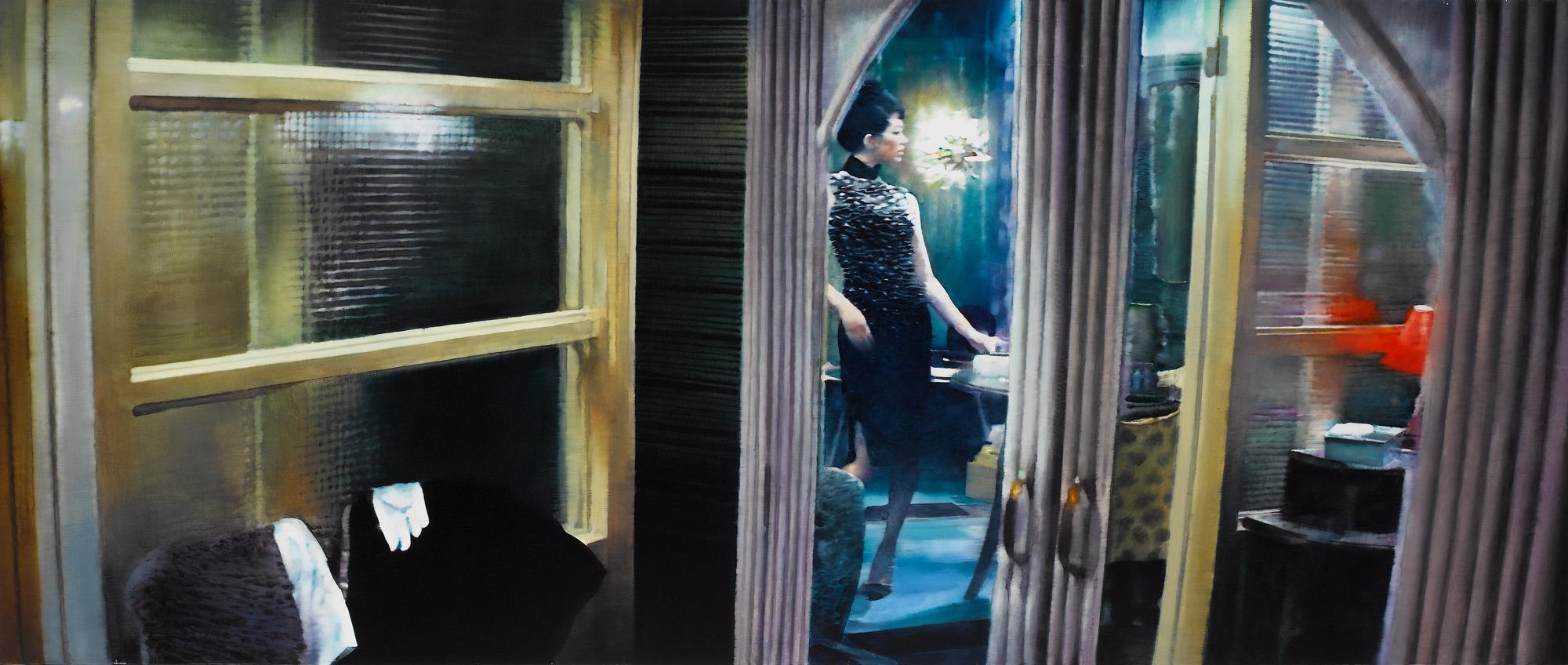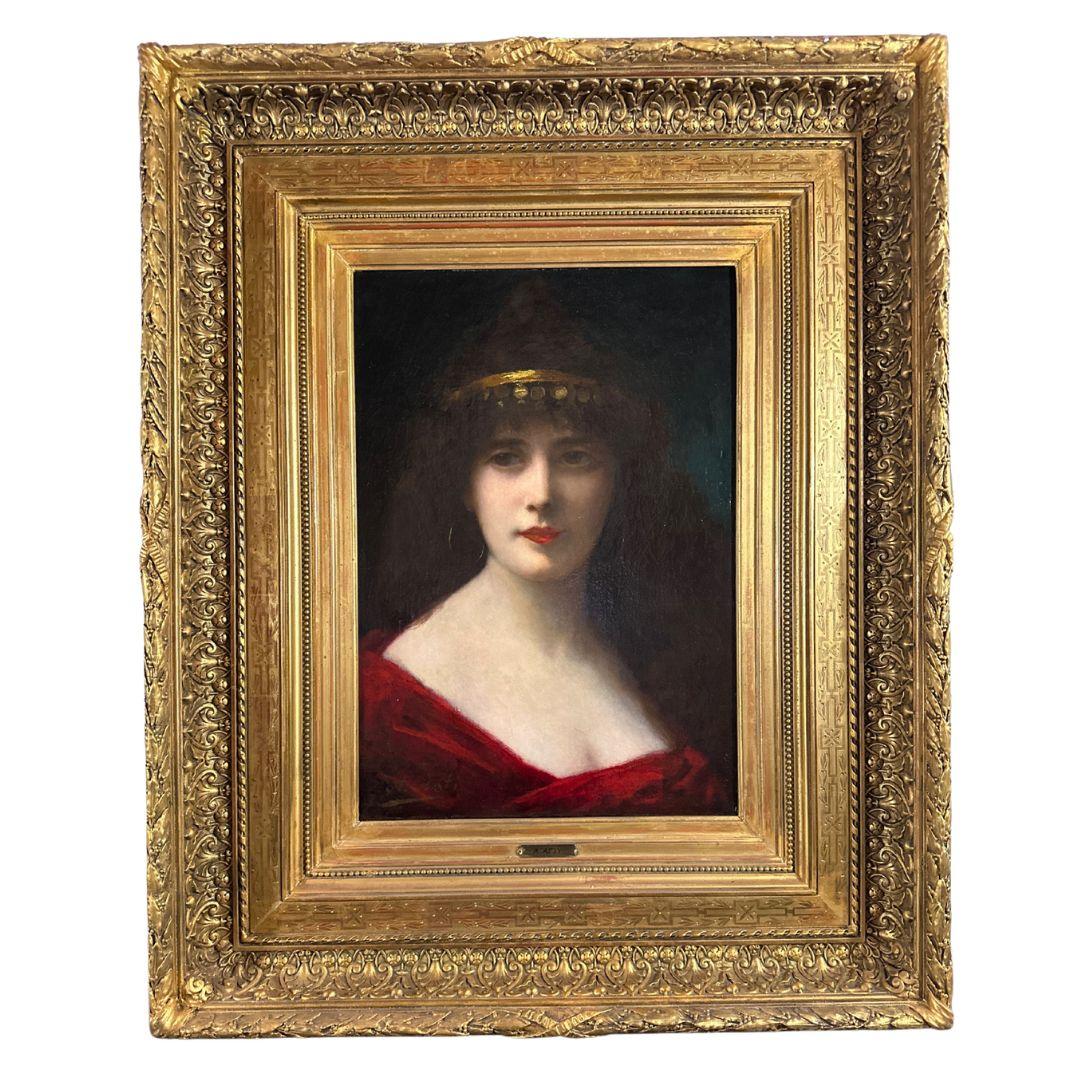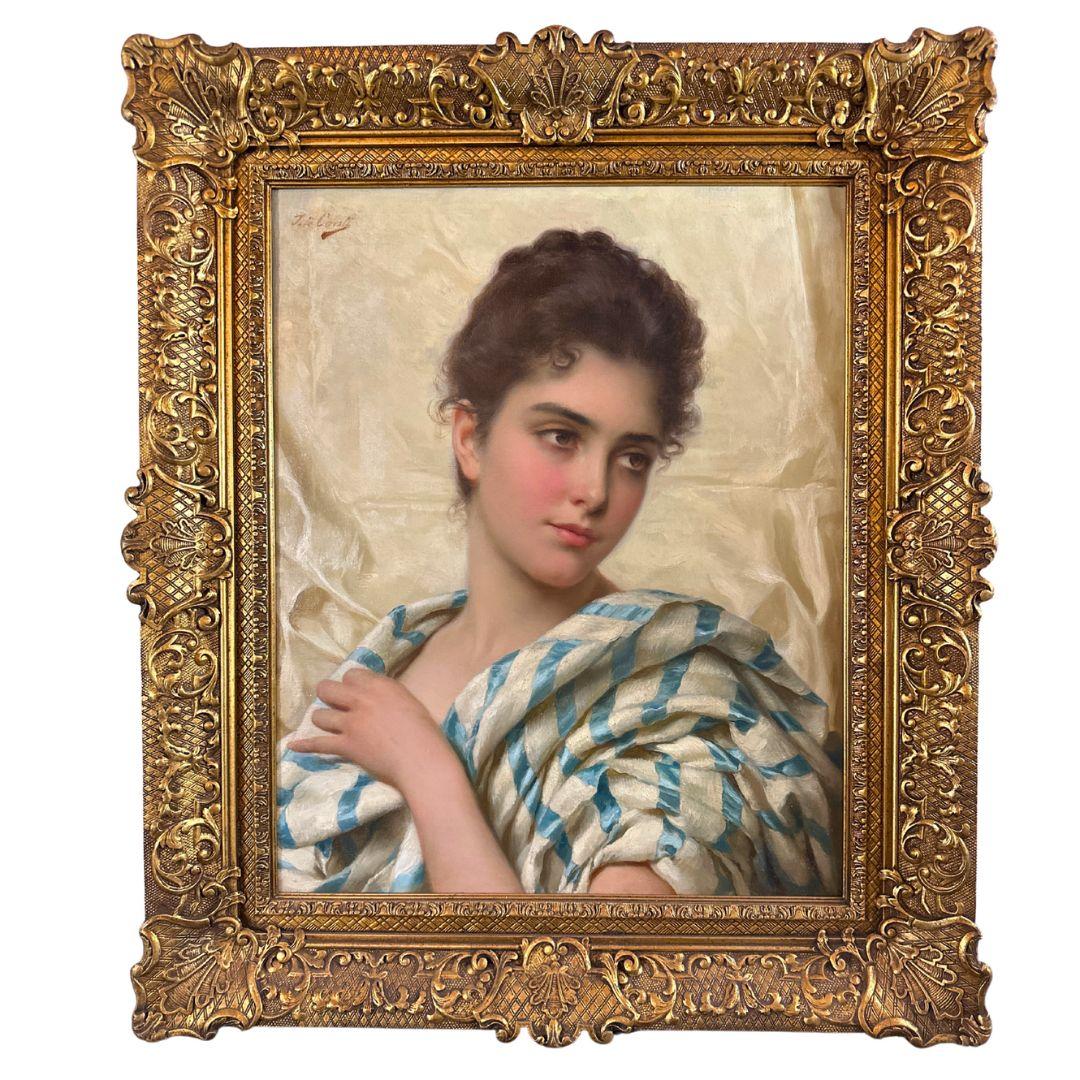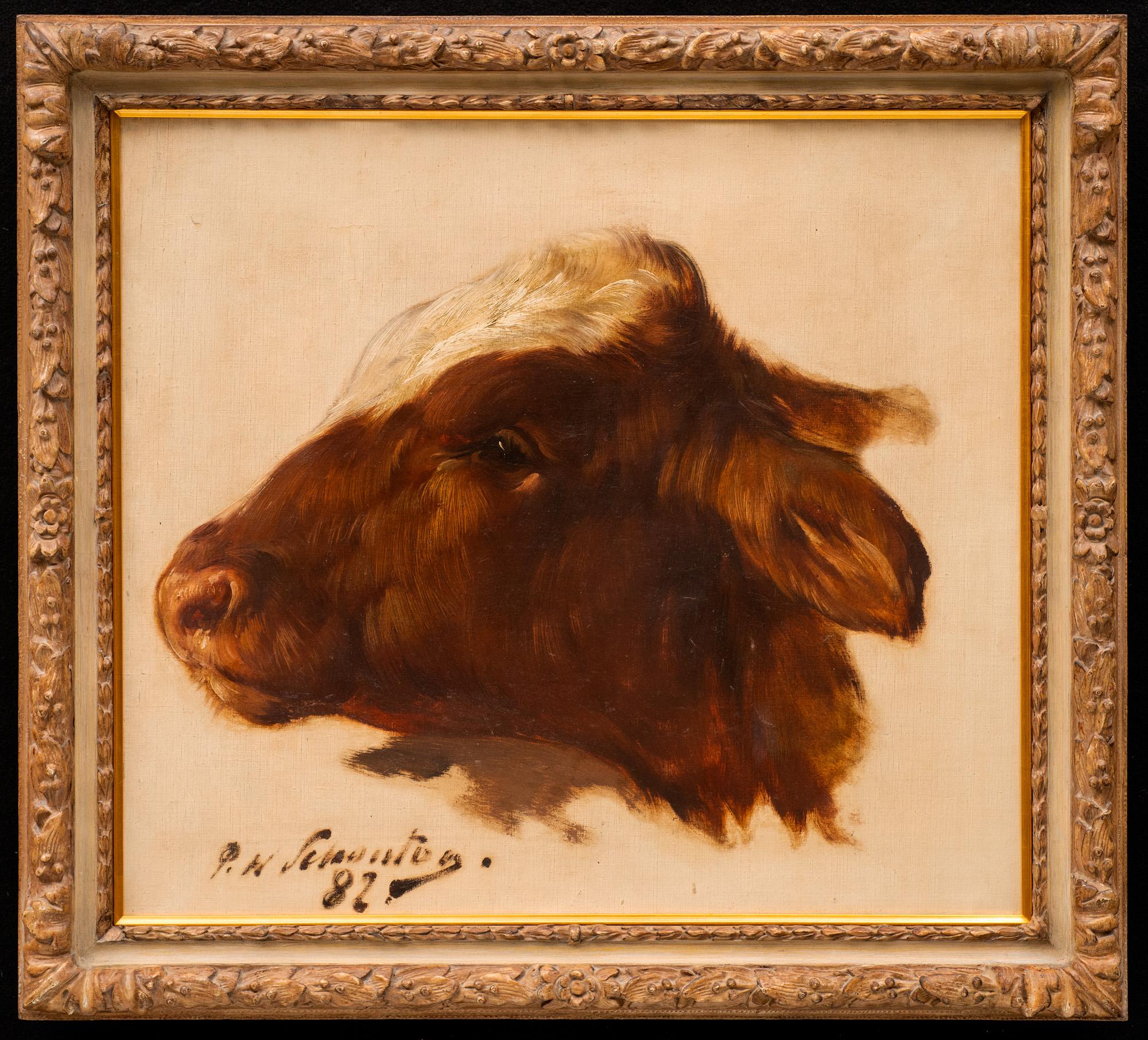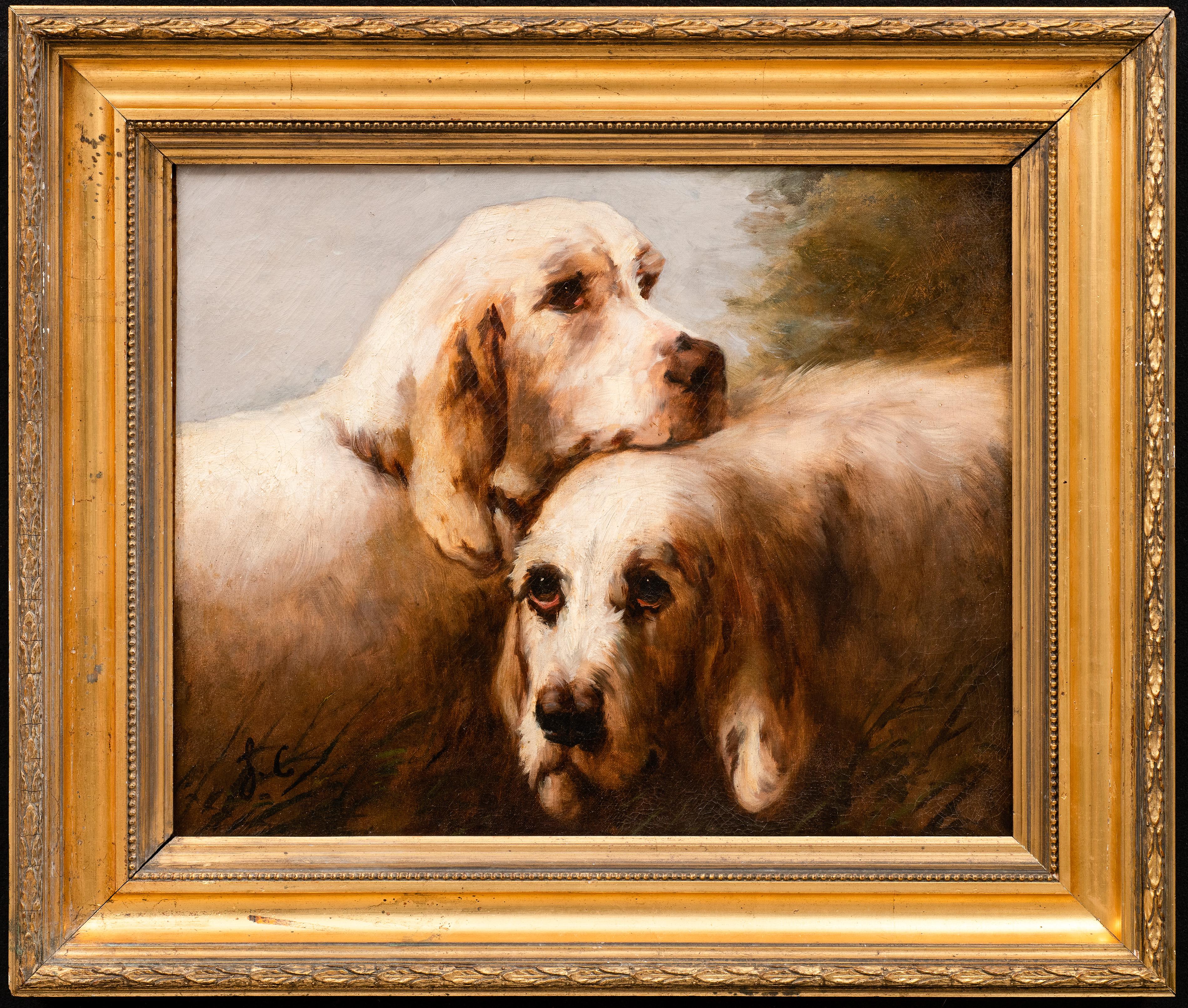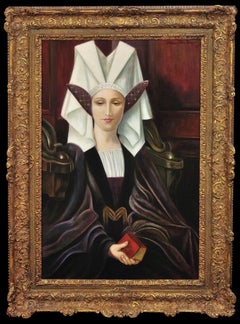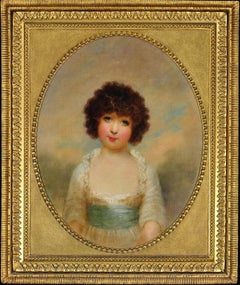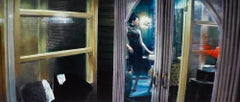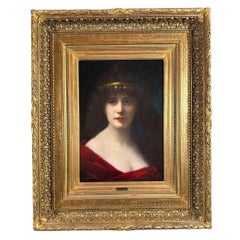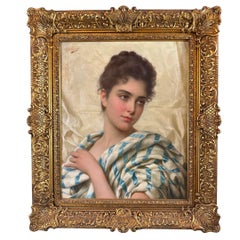Items Similar to Framed 1940s Portrait Painting Katherine Merry Director Horstmann Gear Company
Want more images or videos?
Request additional images or videos from the seller
1 of 24
Howard BarronFramed 1940s Portrait Painting Katherine Merry Director Horstmann Gear Company1946
1946
About the Item
Howard Barron.
English/Australian ( b.1900 - d.1991 ).
Portrait Of Katherine Joan Merry nee Horstmann b.1914 - d.1973.
Director Of The Horstmann Gear Company Of Bath, 1946.
Oil On Canvas.
Signed Lower Left.
Image size 23.2 inches x 19.3 inches ( 59cm x 49cm ).
Frame size 29.7 inches x 25.8 inches ( 75.5cm x 65.5cm ).
Available for sale; this original oil painting portrait is by Howard Barron and dates from 1946.
The painting is presented and supplied in a sympathetic frame (which is shown in these photographs).
The painted surface has benefitted from professional cleaning and conservation, which took place on our instruction, supervision and approval. The painting is now in very good condition and wants for nothing, ready to hang and display.
The painting is signed lower left.
Provenance: Loaned to and exhibited at The Museum of Bath at Work in the city of Bath from 2009 to 2019. Previously with FJ Harris & Son Pictures (Bath) Ltd, 13 & 14 Green Street, Bath in December 1969 for framing.
Howard Barron was an English/Australian painter and draughtsman. He was born in Sidcup, Kent and educated at Christ’s Hospital School, Horsham but migrated to Australia in 1924. He studied in Australia with Will Ashton from 1928-49 and quickly gained a reputation as one of a younger generation of Australian landscape painters. By 1933 his Afternoon, Kangaroo Valley had been purchased by Art Gallery of New South Wales. Throughout the 1940s he was prolific and successful, working in the Newcastle area, around the Hawkesbury, Murrumbidgee and Wollondilly rivers and near Armidale. He was a finalist in the Archibald Prize several times in the 1940s and became an associate member of the Royal Art Society of New South Wales.
Barron returned to England in the late 1940s and practiced widely as a portrait painter. He continued his art studies with Robin Guthrie and Ralph Middleton at the City and Guilds Art School 1950-51. In 1954 he won a silver medal at the Paris Salon and in 1965 he held his first solo exhibition in Britain at the Qantas Gallery.
He lived for a time in Cornwall, where he was elected to membership of a number of art societies including the St. Ives Society of Artists and the International Institute of Art and Letters. He exhibited with the St. Ives Society and also at the Royal Institute of Oil Painters and the Fine Art Society. He also lived in Copthorne, Sussex for some years before returning to Australia in the late 1950s., where he lived until his death in 1991.
Although he made his name as a landscape and marine artist Barron became well known for his portraits of prominent men and women. After the Second World War he was commissioned to paint two portraits of Sir Winston Churchill. On three occasions he was commissioned to paint the Queen and his portrait of Dame Nellie Melba for the main hall of Australia House in London attracted considerable publicity. He also painted a stunning portrait of Florence Austral, another Australian opera singer who achieved an illustrious international career in the first half of the twentieth century. This painting was gifted to the National Portrait Gallery by the University of Newcastle, New South Wales, and is part of the gallery’s collections of twentieth century Australian divas. When four-year-old Monique Grobben of Weston, ACT, was named Miss Pears in 1978 part of her prize was a portrait of her by Howard Barron. He also painted the portraits of many business leaders and institutional heads, so it seems very fitting that he should have also painted Katherine Joan Merry (nee Horstmann).
Today the work of Howard Barron is widely represented in many UK and Australian collections, including the Imperial War Museum in Canberra, and in notable private collections.
© Big Sky Fine Art
The Horstmann company story is one of engineering success that began in 1828 when Gustav Horstmann was born in Westphalia, Germany. He emigrated around 1850 to become foreman of a clock and watchmakers in London. He then moved to Bath where he set himself up as a Watch and Clockmaker. In 1856 he won a prize ‘to devise the most accurate and fool proof device to measure the smallest item.’ This was a micrometer, the original of which is now in the Science Museum. Gustav then patented a device for ‘a new or improved mode of obtaining motive power, which power can be used for winding clocks, timepieces and other mechanisms and also for ventilating hothouses, green houses and all buildings where a uniform temperature is desirable’. He made several self-winding regulator clocks using this principle and then adapted his engineering knowledge and skills into other areas. The Horstmann factory in Bath thrived for many years and was managed by Gustav’s descendants. The now famous Horstmann cars were manufactured in Bath between 1913 and 1929. Approximately 1,500 original cars were made, of which only around nine still exist, seven in the UK and two in New Zealand. The family firm moved out of Bath a few years ago, but the company is now a world leader in the manufacture of heating and hot water controls and wireless controls.
Some of the history of this fascinating family and firm is shown at the Museum of Bath at Work on Julian Road, Bath, Somerset BA1 2RH, UK.
This commissioned portrait of Gustav Horstmann’s granddaughter, Katherine Joan Merry (nee Horstmann) b.1914 - d.1973 was performed by Howard Barron in 1946 when she held the office of Director of The Horstmann Gear Company Limited. The painting was hung in the company premises at the Newbridge Works in Bath, Somerset. She oversaw the transition from wartime production through a difficult hiatus to a major expansion in products and output for domestic and overseas markets in the 1950s.
She is shown from the head to the waist, in a composed and understated pose. She is a very pleasant looking middle-aged lady, with brown hair and brown eyes. She is wearing a pale green dress with matching jacket, with contrasting cream lapel and a simple classical silver coloured brooch. The composition is tastefully and carefully executed to produce a timeless portrait.
© Big Sky Fine Art
- Creator:Howard Barron (1900 - 1991)
- Creation Year:1946
- Dimensions:Height: 29.73 in (75.5 cm)Width: 25.79 in (65.5 cm)Depth: 1.97 in (5 cm)
- Medium:
- Movement & Style:
- Period:
- Condition:This vintage painting is in very good condition, having been cleaned and conserved which took place on our instruction, supervision and approval.. It wants for nothing and is supplied ready to hang and display.
- Gallery Location:Sutton Poyntz, GB
- Reference Number:1stDibs: LU489314227072
About the Seller
5.0
Gold Seller
Premium sellers maintaining a 4.3+ rating and 24-hour response times
Established in 2010
1stDibs seller since 2016
120 sales on 1stDibs
Typical response time: 1 hour
- ShippingRetrieving quote...Shipping from: Sutton Poyntz, United Kingdom
- Return Policy
Authenticity Guarantee
In the unlikely event there’s an issue with an item’s authenticity, contact us within 1 year for a full refund. DetailsMoney-Back Guarantee
If your item is not as described, is damaged in transit, or does not arrive, contact us within 7 days for a full refund. Details24-Hour Cancellation
You have a 24-hour grace period in which to reconsider your purchase, with no questions asked.Vetted Professional Sellers
Our world-class sellers must adhere to strict standards for service and quality, maintaining the integrity of our listings.Price-Match Guarantee
If you find that a seller listed the same item for a lower price elsewhere, we’ll match it.Trusted Global Delivery
Our best-in-class carrier network provides specialized shipping options worldwide, including custom delivery.More From This Seller
View AllHighly Decorative Painting Of A Young Lady With Meadow Flowers In Her Straw Hat
Located in Sutton Poyntz, Dorset
Alice Anne Renshaw.
English ( b.1849 - d.1900 ).
Young Lady With Meadow Flowers In Her Straw Hat.
Watercolor & Gouache On Artist's Board.
( An embossed stamp in the top left hand corner reads 'Turnbull’s Superfine London Board' ) .
Signed Lower Left.
Image size 21.3 inches x 16.7 inches ( 54cm x 42.5cm ).
Frame size 29.9 inches x 25.6 inches ( 76cm x 65cm ).
Available for sale; this original painting is by Alice Anne Renshaw and dates from around 1880.
The painting is presented and supplied in its original highly ornate...
Category
Late 19th Century Realist Figurative Paintings
Materials
Watercolor, Gouache, Board
Framed Bretagne Breton Symbolist Oil Painting Circa 1910 Liturgical Costume
By Edgard Maxence
Located in Sutton Poyntz, Dorset
Follower of Edgard Maxence.
French ( b.1871 - d.1954 ).
Meditation, Circa 1910.
Oil On Canvas.
Image size 34.4 inches x 22.2 inches ( 87.5cm x 56.5cm ).
Frame size 44.1 inches x 31.9...
Category
Early 20th Century Symbolist Figurative Paintings
Materials
Canvas, Oil
Charlotte Shore Daughter Of The Governor General Of India Painted In India
By Arthur William Devis
Located in Sutton Poyntz, Dorset
Arthur William Devis.
English ( b.1762 - d.1822 ).
Portrait Of Charlotte Shore, Daughter Of The Governor General Of India, The 1st Lord Teignmouth.
Oil On Canvas.
Oval Image size 26.2 inches x 20.5 inches ( 66.5cm x 62cm ).
Frame size 34.6 inches x 28.7 inches ( 88cm x 73cm ).
Available for sale; this original oil painting is by Arthur William Devis and dates from around 1792 to 1795.
This painting was created when the sitter and the artist were both in India, the sitter's father being the Governor General of India from 1793 to 1798.
The painting is presented and supplied in a 19th century decorative frame. The painted surfaces and the frame have benefitted from some restoration, cleaning and conservation, which was performed on our instruction, supervision and approval. The canvas is lined.
This antique painting is in very good condition, commensurate with its age. It wants for nothing and is supplied ready to hang and display.
Provenance: By descent in the family of the sitter. Exhibited: Preston, Harris Museum and Art Gallery, 2000, Arthur William Devis, no.52.
Charlotte was the eldest child of the first Baron Teignmouth, a title that was created in 1798 for Sir John Shore. The title became extinct in 1981 on the death of the seventh Baron. This portrait was almost certainly painted by Devis in India at a time when the sitter’s father was Governor General. As such, this is a historically significant piece.
John Shore was an anti-slavery campaigner, born in London but brought up in Romford. In 1769 he went to work in Bengal where he was one of the first to learn a number of local languages. In 1785 he returned to England and on 14 February 1786 he married Charlotte, the only daughter of James Cornish, a medical practitioner at Teignmouth. The couple’s first child, Charlotte, the subject of this painting, was born the following year, on January 26, 1787. The family quickly returned to India, where John Shore served as Governor from 1793 to 1798. John and his wife had three sons and six daughters over the following fifteen years.
Sir John Shore left Calcutta for the final time in March 1798, sailing back to England with his wife and young family. The family settled in Clapham and Sir John became the first president of the British and Foreign Bible Society. He was involved with the Clapham Sect and their anti-slavery campaign.
This adorable original oil on canvas depicts Charlotte, the eldest child and first daughter of the first Lord Teignmouth, aged around five to seven years old. (On the basis that the family returned to England in 1798 when Charlotte would have been 11 years old, this painting was almost certainly created in India, during the time when her father was the Governor General of India. We also know that the artist was painting portraits in India the decade up to 1795, when he returned to England.)
Charlotte is an attractive child, with thick dark brown curly hair framing her beautiful angelic features. She has fair skin, rosy cheeks and rosebud lips. Her dark eyes are wide and engaging. She has the sweetest expression on her face and we feel that she is kind and good natured. She is wearing a simple white gown, typical of the day, with a low neckline and three- quarter length sleeves and a pale blue sash around her waist.
Arthur William Devis was one of the major English artists of the early nineteenth century, noted particularly for his portraits. His life was dynamic and engaging and he produced some of the definitive images of his generation.
Devis was born in London on 10 August 1763, the nineteenth child of the artist Arthur Devis and his wife Elizabeth Faulkner. There were several artists in the family and Devis showed an early genius for art. He received some artistic training from his father and then studied at the Royal Academy Schools where he received a Silver Medal, and the good opinion of Sir Joshua Reynolds.
Devis became extremely well-travelled, and even circumnavigated the world; when he was about twenty, he was appointed draughtsman on the British East India Company's ship Antelope in a voyage to the East Indies, under Captain Henry Wilson. The vessel was wrecked off the Pelew Islands, on which the crew took refuge. The island was uninhabited, but the sailors formed a friendly alliance with neighboroughing islanders and took part in the wars of the natives. The crew then built themselves a small vessel and sailed for Macao. During this voyage Devis received two wounds from arrows shot from the coast, one in his body, the other in his check, which caused a permanent injury to his jaw. Devis left the rest of the crew at Macao, spent a year in China, then proceeded to Bengal. He settled in India for ten years, establishing a modestly successful practice and receiving several lucrative commissions from British colonialists, of which this painting of young Charlotte is likely to be one.
In 1795 he returned to England and worked with great zeal, earning himself a reputation as a serious artist. He painted a number of important historical pieces, including “The Conspiracy of Babington in the reign of Queen Elizabeth” and “Cardinal Langton and the Barons forcing King John to sign Magna”. He soon became established as one of the most talented British artists of his day. It is known that Devis created other portraits of the Shore family between 1797 and 1817.
Devis is particularly noted for being involved in the creation of the posthumous cult of Horatio Nelson. After the battle of Trafalgar, he went out to meet the Victory, and painted the acclaimed piece ‘The Death of Vice-Admiral Lord Viscount Nelson, K.B., in the cockpit of H.M.S. Victory, 21 Oct. 1805.’ For this work Devis made various sketches on board HMS Victory, including of Nelson’s body during the autopsy by Dr. Beatty, the ship’s surgeon. The completed picture has become the definitive image of Nelson’s heroic end; it was engraved by W. Bromley (1812), and presented by the Right Hon. Lord Bexley to the gallery of Greenwich Hospital in 1825. At 8 feet 7 inches by 6 feet 4 inches it is of stunning proportions. Devis’ large oil sketch for the piece was purchased by Queen Victoria, December 1852
Devis was also commissioned by Dr. Beatty to produce a half-length painting of Nelson as Vice Admiral, which was lent to Emma Hamilton, who later lost it whilst travelling. Either the original or a copy of this portrait was exhibited at the Royal Academy two years after the Battle and many copies were made of it, including one in the National Maritime Museum.
Devis exhibited a total of sixty-five pictures at the Royal Academy between 1779 and 1821. His equestrian portrait of ‘Alexander Sinclair Gordon, Esq.’, was engraved by Anthony Cardon in 1805; ‘The Battle of Waterloo,’ engraved by John Burnet in 1819; ‘An Indian Interior,’ by P. W. Tomkins in 1797; ‘The Little Mountaineer,’ by E. Scriven in 1809, who also engraved Devis's illustrations to J. J. Howard's translation of the ‘Metamorphoses of Ovid,’ London, 1807. Thus images of Devis’ work have become well known through the years. Today there is a portrait of Arra Kovger by Devis in the British Museum, and a portrait of Governor Herbert (painted in Calcutta in 1791) in the National Portrait Museum.
Despite his artistic talent, Devis was seemingly completely incapable of managing his financial affairs. He therefore failed to maintain the status in society that his talent deserved. Where money was concerned, he was generous beyond his means and was sadly declared bankrupt in 1800. In 1804 he was imprisoned for debt. Between 1802 and 1810 he received continual assistance from John Biddulph of Ledbury, but these well-intentioned interventions did not produce the results hoped for, and Devis continued to be hopelessly unreliable. Towards the end of his career he at last began to receive Royal patronage, but it came too late. When he died suddenly from apoplexy in 1822 he left his second wife and young children penniless. He was buried in St. Giles’s churchyard.
Works by Arthur Devis are now very much in demand; his depiction of Bengali weavers made an eyecatching £130,000 in a UK auction...
Category
Early 19th Century Romantic Portrait Paintings
Materials
Canvas, Oil
Mother And Child 20TH Century Framed Bold Accomplished Stand Out Modern Artwork
Located in Sutton Poyntz, Dorset
Unknown School.
Second half of the mid-20th Century.
Charcoal, Oil Paint & Spray Paint On Plywood Panel.
Signed Indistinctly.
Image size 26.8 inches x 21.7 inches ( 68cm x 55cm )....
Category
20th Century Modern Portrait Drawings and Watercolors
Materials
Plywood, Charcoal, Oil, Spray Paint
$4,773 Sale Price
30% Off
Framed Self Portrait Of The Curator Of The Toulouse-Lautrec Museum Albi France
Located in Sutton Poyntz, Dorset
Edouard Julien.
French ( b.1883 - d.1966 ).
Self Portrait, 1932.
Oil On Panel.
Image size 17.7 inches x 14.6 inches ( 45cm x 37cm ).
Frame size 20.9 inches x 17.7 inches ( 53cm x 45cm ).
Edouard Julien was an accomplished French painter and lithographer, and long-term curator of the Toulouse-Lautrec Museum in Albi. As a scholar of Toulouse-Lautrec he became an art writer who was sought after by publishers all over the world.
Julien was born in Albi, in the Occitanie region of France in 1883. He had an uncle who was a painter and his parents ran a printing house which specialised in art editions and the printing of lithographs. This would have given the young Edouard a taste for art and a sound understanding of artistic techniques. At 17 he entered the Ecole des Beaux-Arts in Toulouse and studied there throughout 1900 and 1901. He then returned to Albi and took care of the family business, although he also pursued his love of art by working as an artist. By 1903 he was at the Academy in Albi, founded by Bernard-Joseph Artigue, where he became friends with the artist Henri Gourc. In 1928 Julien left Albi again for Paris where he enrolled in the Julian Academy, but he was quickly told that he was an artist, not a student and that they had nothing to teach him about the technique of painting. He therefore rented a studio and worked hard, making friends and exhibiting his works with success.
As an artist Julien loved working in the open air, and his works showed extreme sensitivity. He travelled widely within France to work, and particularly loved the Basque Country, where he met his wife. He also travelled to paint the magical landscapes of Spain, Flanders and North Africa.
At some point Julien returned to Albi, which was also the birthplace of another now more famous French artist whom he admired, namely Henri de Toulouse-Lautrec. This artist was to feature most prominently in the professional life of Edouard Julien.
In 1922 the Toulouse-Lautrec Museum was inaugurated in the prestigious setting of the Palais de la Berbie in Albi. This 13th century building was originally the Bishop’s Palace of Albi Cathedral, next to which it stands. It is dedicated mainly to the work of Henri de Toulouse-Lautrec and, thanks to a bequest from his parents, houses the largest public collection in the world devoted to this artist. Many visitors do not appreciate that this collection owes much of its success to the devotion of Edouard Julien. In 1934 Charles...
Category
Mid-20th Century Post-Impressionist Portrait Paintings
Materials
Oil
Y Bugail Unig The Lonely Shepherd Llangattock The Brecon Beacons Welsh Folklore
By Elin Sian Blake
Located in Sutton Poyntz, Dorset
Elin Siân Blake.
Welsh ( b.1981).
Y Bugail Unig (The Lonely Shepherd), Llangattock, Brecon Beacons.
Oil On Artist’s Canvas Board.
Signed Lower Left.
Image size 9.7 inches x 11.4 inc...
Category
21st Century and Contemporary Realist Landscape Paintings
Materials
Canvas, Oil
$2,970 Sale Price
25% Off
You May Also Like
Hotel Room (Woman in The Mirror)
Located in Natchez, MS
This evocative oil painting by Girbent depicts a woman in a hotel room, visible in the viewers line of sight and also reflected in the mirror. His interior sings with detail while m...
Category
2010s Realist Figurative Paintings
Materials
Canvas, Oil
Dr. Lecter
Located in Natchez, MS
"Dr. Lecter" is a portrait based on Anthony Hopkin's iconic portrayal of the character in Silence of the Lambs. Dr. Hannibal Lecter, though an absolute monster, had a charming side ...
Category
2010s Realist Portrait Paintings
Materials
Canvas, Oil
Gypsy Portrait 19th Century Antique Realistic portrait Oil Painting on Canvas
By Angelo Asti
Located in Jacksonville, FL
The painting is signed on the bottom left side.
Angelo Asti, a renowned Italian artist, established himself as a true maestro of portraiture during the late 19th and early 20th centu...
Category
19th Century Realist Portrait Paintings
Materials
Canvas, Oil
Italian Beauty 19th century Realism Antique Portrait Oil Painting on Canvas
Located in Jacksonville, FL
The painting is signed on the top left side.
Description:
Tito Conti (1842-1924) was an esteemed Italian painter renowned for his exceptional skill in portr...
Category
19th Century Realist Portrait Paintings
Materials
Canvas, Oil
"Portrait of the Head of a Calf" dated 1882, Henry Schouten (1857-1929)
By Henry Schouten
Located in SANTA FE, NM
"Portrait of the Head of a Calf" dated 1882
Henry Schouten (Belgian, 1857-1929)
Oil on canvas
Inscribed "P.H. Schouten (18)82"
23 x 20 1/2 (28 3/8 x 25 1/4 frame) inches
Painted by ...
Category
1880s Realist Animal Paintings
Materials
Canvas, Oil
Large Dog Portrait: Grand Griffon Vendéen Hunting Dogs Jules Chardigny
Located in SANTA FE, NM
Double Portrait: Grand Griffon Vendéen Hunting Dogs
Jules Chardigny (France, 1842-1892) circa 1870
Oil on canvas, signed
21 3/4 x 18 1/4 (29 1/8 x 25 frame) inches
Though pairs of G...
Category
1870s Realist Animal Paintings
Materials
Canvas, Oil
Recently Viewed
View AllMore Ways To Browse
Howard Mid
English Howard
Twos Company Clock
1940s Portraits Of Women
English Car
Original Vintage 1940s Dress Dresses
Original Vintage 1940s Dress
1965 Vintage Watch
Cars For Sale
Vintage 1940S Cars
Retro School Clock
Vintage 1973 Dress
International Vintage Watch Company
Winston Churchill Portrait
Florence Mode
Old England Watches
German Watch Company
Womens Winding Watches
